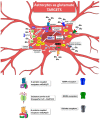The Key Role of Astrocytes in Amyotrophic Lateral Sclerosis and Their Commitment to Glutamate Excitotoxicity
- PMID: 37895110
- PMCID: PMC10607805
- DOI: 10.3390/ijms242015430
The Key Role of Astrocytes in Amyotrophic Lateral Sclerosis and Their Commitment to Glutamate Excitotoxicity
Abstract
In the last two decades, there has been increasing evidence supporting non-neuronal cells as active contributors to neurodegenerative disorders. Among glial cells, astrocytes play a pivotal role in driving amyotrophic lateral sclerosis (ALS) progression, leading the scientific community to focus on the "astrocytic signature" in ALS. Here, we summarized the main pathological mechanisms characterizing astrocyte contribution to MN damage and ALS progression, such as neuroinflammation, mitochondrial dysfunction, oxidative stress, energy metabolism impairment, miRNAs and extracellular vesicles contribution, autophagy dysfunction, protein misfolding, and altered neurotrophic factor release. Since glutamate excitotoxicity is one of the most relevant ALS features, we focused on the specific contribution of ALS astrocytes in this aspect, highlighting the known or potential molecular mechanisms by which astrocytes participate in increasing the extracellular glutamate level in ALS and, conversely, undergo the toxic effect of the excessive glutamate. In this scenario, astrocytes can behave as "producers" and "targets" of the high extracellular glutamate levels, going through changes that can affect themselves and, in turn, the neuronal and non-neuronal surrounding cells, thus actively impacting the ALS course. Moreover, this review aims to point out knowledge gaps that deserve further investigation.
Keywords: amyotrophic lateral sclerosis; astrocytes; autophagy; energy metabolism; glutamate excitotoxicity; glutamate release; mitochondria dysfunction; neuroinflammation; oxidative stress.
Conflict of interest statement
The authors declare no conflict of interest.
Figures



Similar articles
-
Implications for soluble iron accumulation, oxidative stress, and glial glutamate release in motor neuron death associated with sporadic amyotrophic lateral sclerosis.Neuropathology. 2025 Jun;45(3):177-201. doi: 10.1111/neup.13033. Epub 2025 Mar 10. Neuropathology. 2025. PMID: 40065552 Free PMC article. Review.
-
Knocking down metabotropic glutamate receptor 1 improves survival and disease progression in the SOD1(G93A) mouse model of amyotrophic lateral sclerosis.Neurobiol Dis. 2014 Apr;64:48-59. doi: 10.1016/j.nbd.2013.11.006. Epub 2013 Dec 19. Neurobiol Dis. 2014. PMID: 24361555
-
Genetic Downregulation of the Metabotropic Glutamate Receptor Type 5 Dampens the Reactive and Neurotoxic Phenotype of Adult ALS Astrocytes.Cells. 2023 Jul 27;12(15):1952. doi: 10.3390/cells12151952. Cells. 2023. PMID: 37566031 Free PMC article.
-
Astrocytes Pathology in ALS: A Potential Therapeutic Target?Curr Pharm Des. 2017;23(33):5022-5036. doi: 10.2174/1381612823666170615110856. Curr Pharm Des. 2017. PMID: 28619000 Review.
-
Astrocytes release glutamate via cystine/glutamate antiporter upregulated in response to increased oxidative stress related to sporadic amyotrophic lateral sclerosis.Neuropathology. 2020 Dec;40(6):587-598. doi: 10.1111/neup.12716. Epub 2020 Dec 10. Neuropathology. 2020. PMID: 33305472
Cited by
-
Tetraspanins, GLAST and L1CAM Quantification in Single Extracellular Vesicles from Cerebrospinal Fluid and Serum of People with Multiple Sclerosis.Biomedicines. 2024 Oct 2;12(10):2245. doi: 10.3390/biomedicines12102245. Biomedicines. 2024. PMID: 39457558 Free PMC article.
-
Unveiling amyotrophic lateral sclerosis complexity: insights from proteomics, metabolomics and microbiomics.Brain Commun. 2025 Mar 19;7(2):fcaf114. doi: 10.1093/braincomms/fcaf114. eCollection 2025. Brain Commun. 2025. PMID: 40161216 Free PMC article. Review.
-
Glial connexins in glaucoma.Front Neurosci. 2025 Apr 9;19:1560344. doi: 10.3389/fnins.2025.1560344. eCollection 2025. Front Neurosci. 2025. PMID: 40270762 Free PMC article. Review.
-
The Current Landscape of Hypotheses Describing the Contribution of CD4+ Heterogeneous Populations to ALS.Curr Issues Mol Biol. 2024 Jul 23;46(8):7846-7861. doi: 10.3390/cimb46080465. Curr Issues Mol Biol. 2024. PMID: 39194682 Free PMC article.
-
Blood diagnostic and prognostic biomarkers in amyotrophic lateral sclerosis.Neural Regen Res. 2025 Sep 1;20(9):2556-2570. doi: 10.4103/NRR.NRR-D-24-00286. Epub 2024 Sep 24. Neural Regen Res. 2025. PMID: 39314138 Free PMC article.
References
Publication types
MeSH terms
Substances
LinkOut - more resources
Full Text Sources
Medical
Miscellaneous

